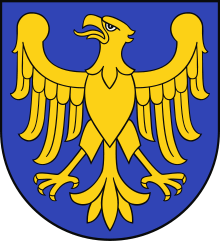Piekary Śląskie
| Piekary Śląskie | |||
|---|---|---|---|
|
| |||
| |||
 | |||
 Piekary Śląskie | |||
| Coordinates: 50°23′N 18°57′E / 50.383°N 18.950°ECoordinates: 50°23′N 18°57′E / 50.383°N 18.950°E | |||
| Country |
| ||
| Voivodeship |
| ||
| County | city county | ||
| Established | 12th century | ||
| Town rights | 1939 | ||
| Government | |||
| • Mayor | Sława Umińska – Duraj | ||
| Area | |||
| • City | 39.98 km2 (15.44 sq mi) | ||
| Highest elevation | 350 m (1,150 ft) | ||
| Lowest elevation | 261 m (856 ft) | ||
| Population (2013) | |||
| • City | 57,917 | ||
| • Density | 1,400/km2 (3,800/sq mi) | ||
| • Urban | 2,746,000 | ||
| • Metro | 4,620,624 | ||
| Time zone | CET (UTC+1) | ||
| • Summer (DST) | CEST (UTC+2) | ||
| Postal code | 41–940 to 41–949 | ||
| Area code(s) | +48 32 | ||
| Car plates | SPI | ||
| Website | http://www.piekary.pl/ | ||
Piekary Śląskie ([pʲɛˈkarɨ ˈɕlɔ̃skʲɛ]) (German: Deutsch Piekar; Silesian: Pjekary) is a city in Silesia in southern Poland, near Katowice. The north district of the Upper Silesian Metropolitan Union – metropolis with the population of 2 million. Located in the Silesian Highlands, on the Brynica river (tributary of the Vistula).
It is situated in the Silesian Voivodeship since its formation in 1999, previously in Katowice Voivodeship, and before then, of the Autonomous Silesian Voivodeship. Piekary Śląskie is one of the cities of the 2.7 million conurbation – Katowice urban area and within a greater Silesian metropolitan area populated by about 5,294,000 people.[1] The population of the city is 59,061 (2008).[2]
Piekary is a spiritual center of Upper Silesia, a Marian shrine which is a pilgrimage site for thousands of the faithful, and a mining town.
History


The town Piekary Śląskie was created in 1934 by joining the communes of Szarlej and Wielkie Piekary. In 1975, the administrative reform led to joining the nearby towns: Dąbrówka Wielka, Brzeziny Śląskie, Brzozowice, Kamień and Kozłowa Góra.
Between 1303 and 1318, the first church and independent parish were created there. In the 15th century, the zinc and lead mining industry developed and the process of settlement evolution begun.
In the 12th and 14th centuries, the Germanised Silesian dukes governed the town, but a short visit of the King John III Sobieski rushing to relief Vienna in 1683 cause that memory about the Polish origin livened among them. The next years brought several peasant revolts against the German magnates. In 1697, Augustus II the Strong visited Piekary. He converted to Catholic religion in the local church and at the same time he sworn the pacta conventa.
In the 18th century, colonisation and Germanisation of Piekary Śląskie was increased. The result was a strong movement towards maintaining the Polish origins of the land. In 1842, Piekary's rector, priest Alojzy Ficek, commissioned a new neo-romanesque basilica designed by Daniel Grötschel. A painting of the Virgin Mary was placed there. It was one of the centers of Silesian Uprisings and in 1922 was ceded to the Second Polish Republic by Weimar Germany as 86% of the population voted for joining the re-established Polish state.
Districts
- 1 Kozłowa Góra
- 2 Piekary-Centrum
- 3 Szarlej (German: Scharley)
- 4 Brzozowice
- 5 Kamień
- 6 Brzeziny Śląskie
- 7 Dąbrówka Wielka
People
- Hans Kroll
- Karol Langner
- Wilhelm Antoni Góra
- Hans Marchwitza, born at Szarlej
- Adam Matysek
- Jerzy Polaczek
- Marek Siwiec
- Walter Winkler
- Dariusz Wosz
External links
- Piekary, Silesia
- Jewish Community in Piekary Śląskie on Virtual Shtetl
References
Notes
- ↑ European Spatial Planning Observation Network (ESPON)
- ↑ Powierzchnia i ludność w przekroju terytorialnym w 2008 – Central Statistical Office in Poland ISSN 1505-5507 , 13.08.2008



